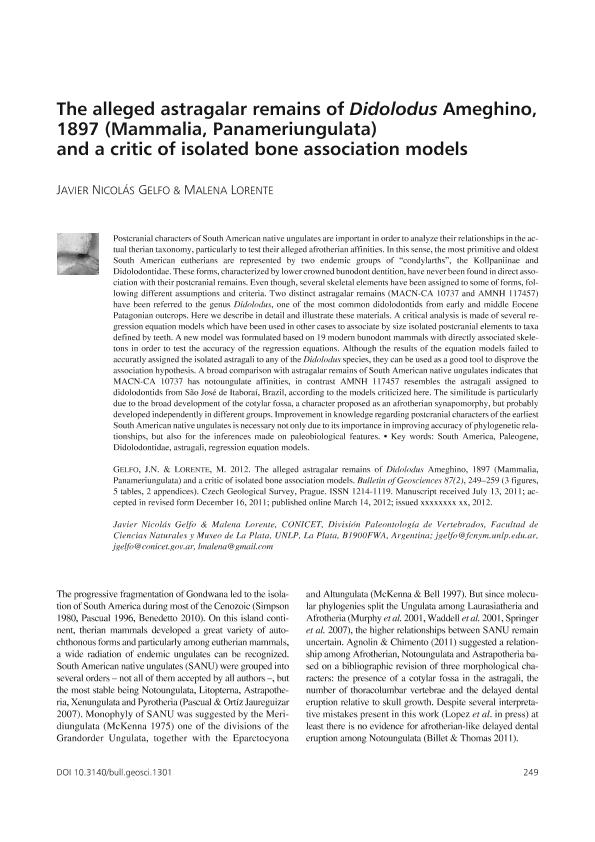Artículo
The alleged astragalar remains of Didolodus Ameghino, 1897 (Mammalia, Panameriungulata) and a critic of isolated bone association models
Fecha de publicación:
01/2012
Editorial:
Czech Geological Survey
Revista:
Bulletin of Geosciences
ISSN:
1214-1119
e-ISSN:
1802-8225
Idioma:
Inglés
Tipo de recurso:
Artículo publicado
Clasificación temática:
Resumen
Postcranial characters of South American native ungulates are important in order to analyze their relationships in the actual therian taxonomy, particularly to test their alleged afrotherian affinities. In this sense, the most primitive and oldest South American eutherians are represented by two endemic groups of "condylarths", the Kollpaniinae and Didolodontidae. These forms, characterized by lower crowned bunodont dentition, have never been found in direct association with their postcranial remains. Even though, several skeletal elements have been assigned to some of forms, following different assumptions and criteria. Two distinct astragalar remains (MACN-CA 10737 and AMNH 117457) have been referred to the genus Didolodus, one of the most common didolodontids from early and middle Eocene Patagonian outcrops. Here we describe in detail and illustrate these materials. A critical analysis is made of several regression equation models which have been used in other cases to associate by size isolated postcranial elements to taxa defined by teeth. A new model was formulated based on 19 modern bunodont mammals with directly associated skeletons in order to test the accuracy of the regression equations. Although the results of the equation models failed to accuratly assigned the isolated astragali to any of the Didolodus species, they can be used as a good tool to disprove the association hypothesis. A broad comparison with astragalar remains of South American native ungulates indicates that MACN-CA 10737 has notoungulate affinities, in contrast AMNH 117457 resembles the astragali assigned to didolodontids from São José de Itaboraí, Brazil, according to the models criticized here. The similitude is particularly due to the broad development of the cotylar fossa, a character proposed as an afrotherian synapomorphy, but probably developed independently in different groups. Improvement in knowledge regarding postcranial characters of the earliest South American native ungulates is necessary not only due to its importance in improving accuracy of phylogenetic relationships, but also for the inferences made on paleobiological features.
Palabras clave:
ASTRAGALI
,
DIDOLODONTIDAE
,
PALEOGENE
,
REGRESSION EQUATION MODELS
,
SOUTH AMERICA
Archivos asociados
Licencia
Identificadores
Colecciones
Articulos(CCT - LA PLATA)
Articulos de CTRO.CIENTIFICO TECNOL.CONICET - LA PLATA
Articulos de CTRO.CIENTIFICO TECNOL.CONICET - LA PLATA
Citación
Gelfo, Javier Nicolás; Lorente, Malena; The alleged astragalar remains of Didolodus Ameghino, 1897 (Mammalia, Panameriungulata) and a critic of isolated bone association models; Czech Geological Survey; Bulletin of Geosciences; 87; 2; 1-2012; 249-259
Compartir
Altmétricas




